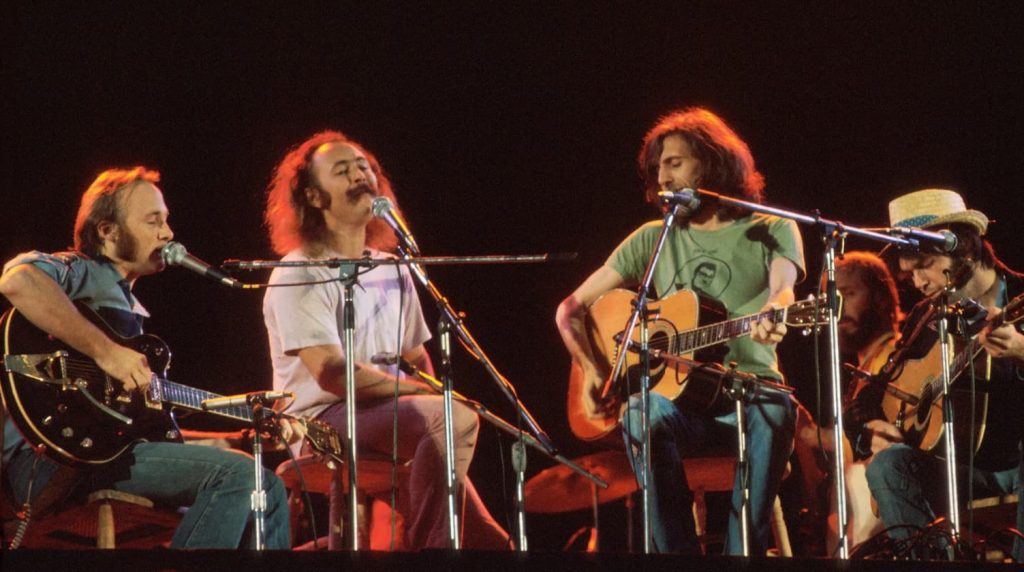
A Poignant Ode to a Lost Love and a Defining Anthem of a Generation
“Suite: Judy Blue Eyes” by Crosby, Stills & Nash (CSN) isn’t just a song; it’s a journey, a tapestry of emotions woven into a complex and beautiful musical suite. Released in 1969 on their self-titled debut album, Crosby, Stills & Nash, this masterpiece peaked at number 21 on the Billboard Hot 100, a significant achievement for such an unconventional and lengthy track. It resonated deeply with listeners, becoming an anthem of the era and solidifying CSN’s place in music history.
This epic composition, primarily penned by Stephen Stills, is a deeply personal reflection on his tumultuous relationship with singer-songwriter Judy Collins. The “Judy Blue Eyes” of the title is, in fact, a direct reference to her. The song serves as a musical chronicle of their romance’s unraveling, capturing the spectrum of emotions Stills experienced during their breakup. It’s a raw, honest, and vulnerable portrayal of love, loss, and the bittersweet acceptance of change.
The structure of “Suite: Judy Blue Eyes” is what truly sets it apart. It’s not a standard verse-chorus structure; instead, it’s a medley of distinct sections, each with its own melody, tempo, and mood. This “suite” format allows Stills to explore the various facets of his emotional state. From the gentle, folk-infused opening to the upbeat, almost celebratory “Carry On” section, the song takes the listener on a rollercoaster of feelings.
The opening section, with its delicate acoustic guitar and heartfelt vocals, immediately establishes a sense of intimacy. Stills’ lyrics paint a vivid picture of his longing and confusion, capturing the pain of a love slipping away. As the suite progresses, the music evolves, reflecting the shifting dynamics of the relationship. The more upbeat sections, like the iconic “doo-wop” interlude, offer moments of respite, perhaps symbolizing fleeting moments of hope or denial.
The “Carry On” section, with its driving rhythm and powerful harmonies, provides a sense of closure. It’s an affirmation of resilience, a declaration of moving forward despite the heartbreak. This section became a rallying cry for a generation grappling with social and political upheaval, resonating with their desire for change and a brighter future.
Beyond its personal significance for Stills, “Suite: Judy Blue Eyes” also represents a pivotal moment in the formation of CSN. The intricate vocal harmonies, a hallmark of their sound, are on full display here, showcasing the unique blend of their voices. The song’s complex arrangement and dynamic instrumentation further demonstrate their musical prowess and innovative approach to songwriting.
The album, Crosby, Stills & Nash, was released at a time of immense cultural change, and this song in particular, became a soundtrack to that era. It spoke to the anxieties, hopes, and dreams of a generation searching for meaning and connection. It’s a testament to the power of music to capture the human experience in all its complexity.
Today, “Suite: Judy Blue Eyes” remains a timeless classic, a testament to the enduring power of heartfelt songwriting and musical innovation. It’s a song that continues to resonate with listeners of all ages, reminding us of the universal experiences of love, loss, and the enduring human spirit. It’s a song that invites us to reflect on our own journeys, our own heartbreaks, and our own capacity to carry on. For many, especially those who came of age in the late 60s and early 70s, hearing that opening acoustic guitar riff is like stepping back in time, evoking a powerful sense of nostalgia and reminding them of a time when music truly had the power to change the world. It was indeed a powerful anthem in the Woodstock festival, a significant event of the time. This further cemented its status as an iconic song of the era.